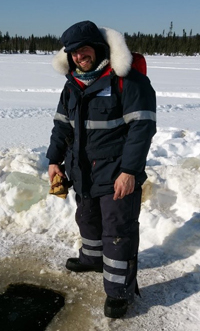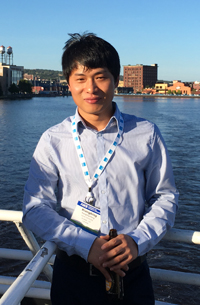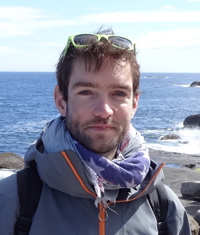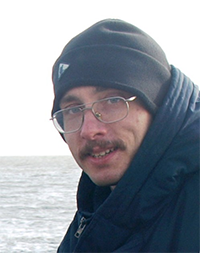 |
Matthias WinkelMatthias is a former PostDoc of the section Geomicrobiology in the GFZ, German Research Centre for Geosciences and worked for four years in the Young Investigator Group under the supervision of Susanne Liebner. During his last year he got a subaward from the University of Fairbanks Alaska and joined a project lead by Katey Walter Anthony, Anna Liljedahl, Ronald D. Daanen, Vladimir Romanovsky and David Barnes. He worked/ still working on deep permafrost thaw environments such as submarine permafrost, thermokarst lakes and try to understand the organic matter degradation and greenhouse gas production as well as the mitigation of the gases (anaerobic oxidation of methane). Since these environments are chronosequences that thaw over long timescales these are perfect examples of how the microbial community will evolve in a globally changing climate. He is also working on active layer microbial communities in permafrost-affected peatlands and the influence of hydrology due to climate warming. He mainly uses molecular tools to characterize the microorganisms, analyze the biogeochemical background, use stable isotopes to understand specific processes and made my first steps into modelling. Now he moved to the section Interface Geochemistry and will mainly be working on snow and ice algae. He will try to understand the adaptation in these harsh ecosystems and will focus on the genomic repertoire of the algae. |
 |
Samuel GagnonSamuel after majoring in environmental science at Bishop’s University (QC, Canada), knew that he wanted to do a master’s degree. In one of his classes during his last year of undergraduate studies, he was introduced to the issues that the Arctic regions are facing and he felt strongly about them. So he decided to pursue a master’s degree at Laval University in geography, specializing in permafrost and soil carbon emissions. After his master’s, he wanted to keep studying permafrost, so he started a PhD in geography at Laval University, studying permafrost degradation and ice wedge activity. |
 |
Xiangbing KongXiangbing Kong is currently a Ph.D. student in the Department of Civil Engineering and Water Engineering, Laval University in Quebec, Canada. His research direction is to assess the performance of different mitigation techniques to preserve permafrost under north transportation infrastructures. The project began since June, 2015. |
 |
Evan WilcoxEvan is a second year PhD Geography student at Wilfrid Laurier University in Waterloo, Ontario, Canada. His research is focused on quantifying the hydrological variability of upland tundra lakes across a 5000 km2 area between Inuvik and Tuktoyaktuk in the Western Canadian Arctic. Most of his field work is based out of Trail Valley Creek Research Station, where he has spent 9 months over the past three and a half years. |
 |
Samuel WeberSamuel's research interest concerns heterogeneous environments and climate change, especially process understanding and quantification of phenomena in mountain permafrost related to climate. His vision is to investigate fracture kinematics, to improve the understanding of processes in mountain permafrost using geophysical methods, to detect rupture processes in instable rock masses, assess rupture imminence and to design an early warning system for rock instabilities. For this, the combination of geo-science and engineering is very useful and enables field measurements at locations in hardly accessible environments. He greatly enjoys doing field work in alpine environments and being able to combine his knowledge as well as my experience with my alpine skills. |
 |
Dmitry NekrasovDmitry is a PhD student at Lomonosov Moscow State University, Faculty of Geography. His current research project is focused on the composition of tabular ground ice on Central Yamal. Dmitry became a PYRN member in 2013 when entered MSc program on Cryolithology and Glaciology department. The first time he got involved in arctic related international cooperation during EUCOP4 in 2014. Since then he took part in the several Arctic themed forums, workshops, and courses in Russia and Norway. He has various interests and competencies including geomorphology, palaeogeography, geocryology, environmental monitoring of oil&gas industry, project management. Dmitry will be responsible for PYRN newsletter, promotion, and outreach. |
 |
Isabel PraterIsabel does her PhD at the Chair of Soil Science at the Technical University of Munich. First focusing on game theory and nuclear deterrence during her M.A. in political science at the Ludwig-Maximilians-Universität Munich, she discovered her enthusiasm for soil science during her BSc in agricultural science at the University of Hohenheim. Her fondness for barren landscapes initialized her first contact to Russian soils in the western steppe. During her MSc in agricultural science at the Technical University of Munich her attentions moved towards colder regions and she worked with soils from the Antarctic Peninsula for her thesis. Continuing this work, she now examines the fate of soil organic carbon in permafrost-affected soils from both hemispheres: deep developed carbon-rich soils from the Russian Arctic and little developed soils with low contents of organic matter from the Antarctic Peninsula. Isabel joined PYRN in 2017. |
 |
Huw MithanHuw is a periglacial geomorphologist interested in understanding landform processes in periglacial environments. His current research aims are to understand the role of topography and ground ice at initiating shallow translational landslides in permafrost, called Active Layer Detachments (ALDs). |
 |
Julien FoucheJulien Fouché is a postdoctoral fellow at the University of Liège in Belgium. His researches focus on the characterization of organic matter in soils and rivers, and the assessment of the net ecosystem carbon balance in Arctic and Boreal environments in Canada. His studies aim to better understand the impacts of warming and permafrost degradation on the carbon and nitrogen cycles and the biogeochemical functioning of permafrost soils. |
 |
Jannik MartensJannik is a PhD candidate in Environmental Science at Stockholm University and the Bolin Center for Climate Research, Sweden. His research project explores the mobilization and spatial distribution of permafrost carbon to Arctic Ocean sediments. This includes molecular, isotopic analysis and source modelling of organic carbon in marine sediment cores from the Siberian Shelf to study remobilization of permafrost carbon over the last glacial-interglacial transition. Furthermore, he is part of a large collaborative research network to develop an Arctic shelf sediment carbon database. Jannik joined the PYRN Executive Committee in 2016 during the International Conference on Permafrost (Potsdam, Germany) after he became interested in permafrost research during his post-graduate studies at the University of Cologne, Germany. Over the course of his studies, Jannik traveled to the Arctic repeatedly, studied at the University Centre of Svalbard (Norway) and was involved in a German-Russian expedition to Siberia in collaboration with the Alfred-Wegener-Institute, Potsdam. In 2017 he started his PhD education at Stockholm University. |
 |
Helena BergstedtHelena Bergstedt is a PhD researcher in the Doctoral College GIScience at the Z_GIS at University of Salzburg. My PhD project focusses on freeze/thaw cycles of permafrost land surfaces and the opportunities that microwave remote sensing provides in this area of science. I work with scatterometer and SAR data (mainly C-Band) to answer questions concerning timing and spatial distribution of freeze and thaw events. My projects focus on the alpine region of Austria and artic environments (in particular Yamal, Russia). |
 |
Denis FrolovDenis is a research fellow in the laboratory of avalanches and mudflows at Faculty of Geography, Lomonosov Moscow State University. His research interests include snow cover and climatic spacial and time alterations as well as regularities of snow cover formation and the processes of heat and mass transport in snow cover and on the boundary with ground while ground freezing.Participated in expeditions to Caucasus, New Siberian islands and other parts of Russian Arctic. He is a webmaster of the new PYRN website. |
